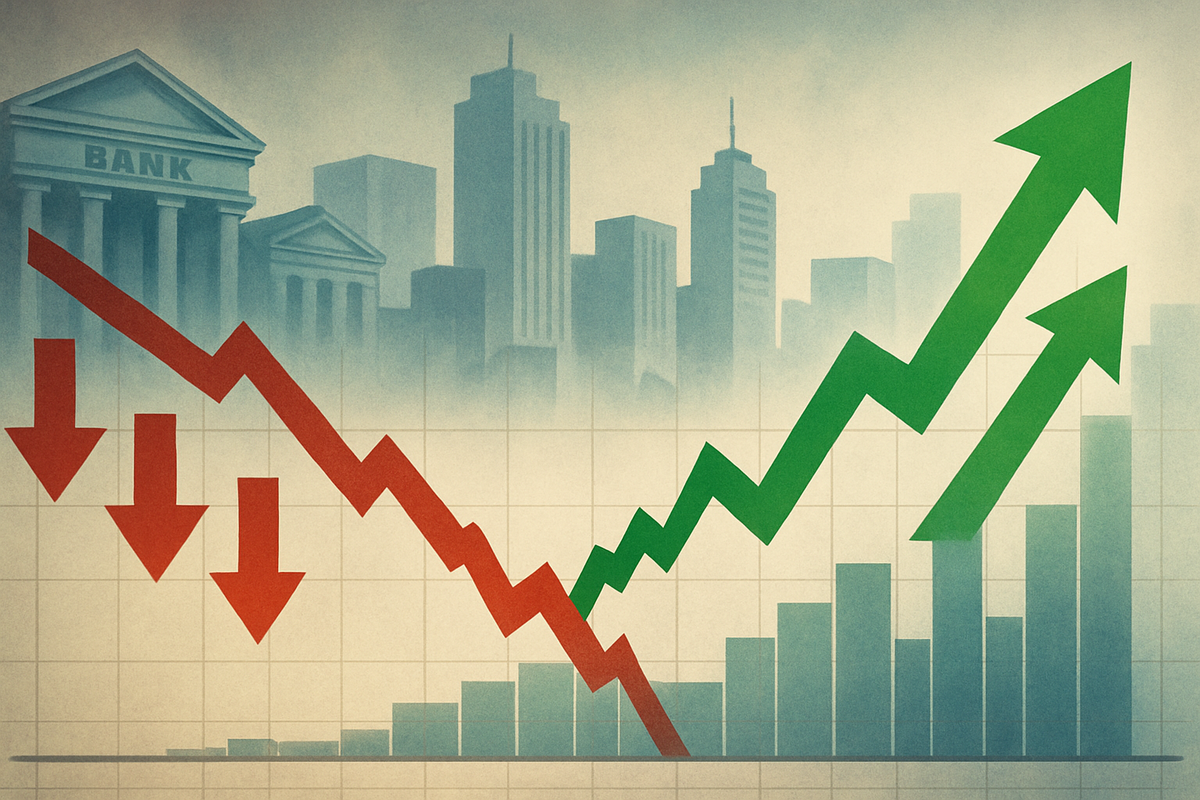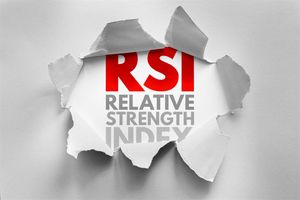Financial News
Financials Sector Stages Dramatic Rebound as Bank Credit Fears Recede on Hypothetical October 17, 2025

New York, NY – October 17, 2025 – The S&P 500 Financials sector (NYSEARCA: XLF) experienced a day of remarkable volatility and ultimate recovery today, as initial "bank credit worries" that triggered a significant morning sell-off ultimately eased, allowing stocks to close higher. This hypothetical scenario paints a picture of a market grappling with underlying anxieties about lending health but ultimately finding reassurance, suggesting a resilience within the banking system and a potential for renewed investor confidence in the sector's outlook. The dramatic turnaround underscores the sensitivity of financial stocks to perceived credit risk and the swiftness with which market sentiment can shift.
This prospective event illustrates how a sector heavily reliant on economic stability and robust credit markets can be whipsawed by rumors or initial reports of distress. The initial "big sell-off" would have reflected deep-seated concerns over potential loan defaults, tightening lending standards, and the broader economic implications. However, the subsequent "stocks close higher" indicates that whatever specific concerns arose, they were either mitigated by new information, strong reassurances from key players, or an overall market belief that the underlying fundamentals of the financial institutions were sound enough to weather the storm. This hypothetical rebound sets a potentially positive tone for the financial markets, suggesting a capacity to absorb and overcome credit-related anxieties.
Unpacking the Day's Hypothetical Dynamics: From Panic to Poise
In this imagined scenario, the morning of October 17, 2025, likely opened with a wave of selling pressure across the Financials sector, driven by speculative reports or early indicators suggesting a deterioration in bank credit quality. Such worries often stem from fears of rising interest rates impacting borrowers' ability to repay, an economic slowdown increasing corporate bankruptcies, or specific loan portfolio weaknesses within major institutions. The initial market reaction would have been sharp and indiscriminate, with investors shedding financial holdings broadly as a knee-jerk response to avoid potential losses. This "big sell-off" could have seen major banking institutions like JPMorgan Chase & Co. (NYSE: JPM), Bank of America Corp. (NYSE: BAC), and Wells Fargo & Co. (NYSE: WFC) facing significant downward pressure, dragging the entire sector into negative territory.
The pivotal shift, however, occurred as the day progressed. The easing of "bank credit worries" could have been triggered by several factors. Perhaps a major regulatory body, such as the Federal Reserve, issued a statement clarifying the health of the banking system, or perhaps leading financial institutions released updated, reassuring financial guidance or stress test results. It's also plausible that analysts and market commentators, after initial panic, began to dissect the actual data, finding the fears to be overblown or localized rather than systemic. This reassessment would have led to a gradual, then accelerating, buying spree, as investors who had sold off in fear rushed back in to capitalize on what they now perceived as undervalued assets. The timeline would thus show a rapid decline followed by a steady climb, culminating in a positive close for the sector.
Key players involved in such a hypothetical event would extend beyond the banks themselves. Regulatory bodies like the Federal Reserve, the Office of the Comptroller of the Currency (OCC), and the Federal Deposit Insurance Corporation (FDIC) would be crucial in providing stability and information. Major institutional investors and hedge funds, through their trading activity, would significantly influence the market's direction. Their initial reactions of selling, followed by their re-entry into the market, would underscore the collective psychology at play. The initial market reaction would be one of fear and uncertainty, with financial news outlets broadcasting dire warnings. However, as the narrative shifted towards reassurance, the headlines would pivot to focus on the sector's resilience and robust recovery.
Winners and Losers in a Volatile Market
In a scenario where bank credit worries initially trigger a sell-off but then ease, the immediate winners would be the well-capitalized, diversified financial institutions with strong balance sheets and robust risk management practices. Banks like JPMorgan Chase & Co. (NYSE: JPM) and Goldman Sachs Group Inc. (NYSE: GS), often seen as bellwethers of the financial industry due to their extensive operations and global reach, would likely experience the sharpest rebounds. Their ability to weather perceived credit storms, coupled with their strong liquidity positions, makes them attractive targets for investors seeking to re-enter the market once fears subside. These institutions might also benefit from increased trading volumes during the volatility, boosting their investment banking and trading arms.
Conversely, smaller regional banks and those with concentrated loan portfolios in potentially vulnerable sectors (e.g., commercial real estate, highly leveraged corporate loans) might initially suffer more significantly and recover more slowly. These institutions, such as certain regional players, could face heightened scrutiny regarding their asset quality and capital buffers. Even if the broader credit worries ease, the initial scare could highlight perceived weaknesses, leading to a lingering discount on their stock prices compared to their larger, more diversified counterparts. Investors might become more selective, favoring institutions with demonstrable resilience and less exposure to specific credit risks.
Beyond direct banking, financial technology (FinTech) companies that provide services to banks or operate in adjacent spaces could also see varied impacts. Those offering solutions that help banks manage risk or streamline operations might experience increased demand as banks seek to fortify against future credit shocks. However, FinTech lenders that rely heavily on easily accessible credit markets could face headwinds if the initial fears, even if temporary, lead to a tightening of overall lending conditions or a more cautious investor sentiment towards riskier debt. Asset managers and wealth management firms, such as BlackRock Inc. (NYSE: BLK) and Morgan Stanley (NYSE: MS), would also feel the effects, as market volatility impacts their assets under management and client sentiment, though a quick recovery could mitigate long-term damage.
Wider Significance and Industry Repercussions
This hypothetical event on October 17, 2025, would fit into a broader industry trend of heightened sensitivity to credit cycles and economic indicators, especially in a post-pandemic world where the long-term impacts of fiscal and monetary policies are still unfolding. The rapid shift from "big sell-off" to "stocks close higher" underscores the market's current state of vigilance regarding financial stability. It suggests that while investors are quick to react to perceived threats, there is also an underlying belief in the fundamental soundness of the banking system, possibly bolstered by years of post-2008 regulatory reforms. This event would highlight the ongoing tug-of-war between economic growth aspirations and the ever-present risk of credit deterioration.
The potential ripple effects on competitors and partners would be significant. Non-bank lenders, for instance, might find their funding costs temporarily increase if the initial credit worries create a broader tightening in the bond markets. Companies across all sectors that rely on bank financing for their operations and expansion plans could face a brief period of uncertainty regarding credit availability, even if the fears ultimately subside. Regulatory bodies would undoubtedly review the incident, potentially leading to calls for further stress tests, enhanced reporting requirements, or adjustments to capital adequacy rules, especially if the initial scare revealed any systemic vulnerabilities. Historically, similar events, such as the flash crashes or sudden market corrections often seen during periods of economic uncertainty, have led to increased scrutiny and, in some cases, new regulations aimed at preventing such rapid unwinding of market confidence. The 2008 financial crisis, while far more severe, serves as a stark reminder of how quickly credit fears can escalate and the lasting regulatory changes they can precipitate.
This event also highlights the effectiveness (or lack thereof) of current communication channels between financial institutions, regulators, and the market. A swift and credible response from authorities or leading banks would be crucial in calming nerves and reversing the initial sell-off. The incident would serve as a real-time test of the financial system's ability to absorb shocks and communicate effectively under pressure, potentially influencing future strategies for crisis management and public relations within the sector.
What Comes Next: Navigating the Aftermath
In the short term, following such a dramatic rebound on October 17, 2025, the Financials sector would likely experience a period of consolidation. Investors would meticulously analyze the specifics of what caused the initial scare and what ultimately led to its resolution. This would lead to a more nuanced differentiation between financial institutions, with those perceived as having superior risk management and more resilient business models potentially outperforming. Short-term possibilities include increased trading volumes as investors adjust their positions and a heightened focus on corporate earnings reports and forward guidance from banks in the coming weeks. Any lingering uncertainty, however, could lead to continued volatility.
Long-term possibilities include a reinforced focus on credit quality and risk management within the financial industry. Banks might strategically pivot towards more conservative lending practices or diversify their revenue streams further to reduce reliance on interest income. Market opportunities could emerge for investors willing to delve into the fundamentals, identifying strong financial institutions that were unfairly punished during the initial sell-off. Conversely, challenges might arise for institutions with weaker balance sheets or those operating in niche markets that remain susceptible to credit shocks. Potential scenarios range from a sustained period of recovery and growth, assuming the credit fears were truly unfounded, to a more cautious market environment where any new hint of credit distress could trigger another rapid downturn.
Regulators, having witnessed the market's swift reaction, might initiate deeper dives into the health of specific loan portfolios or the interconnectedness of financial institutions. This could lead to new stress test scenarios or adjustments to capital requirements, particularly for institutions deemed systemically important. For investors, the event underscores the importance of a diversified portfolio and a clear understanding of the underlying risks associated with financial sector investments. The market will be watching closely for any further developments regarding credit quality, economic indicators, and regulatory pronouncements in the months following this hypothetical event.
Comprehensive Wrap-Up: Resilience Under Scrutiny
The hypothetical market day of October 17, 2025, for the S&P 500 Financials sector serves as a potent reminder of the inherent volatility and rapid sentiment shifts that characterize financial markets. The initial "big sell-off" driven by "bank credit worries," followed by a robust recovery to "stocks close higher," highlights the market's capacity for both fear-driven overreaction and fundamental reassessment. Key takeaways include the critical importance of transparent communication from financial institutions and regulators in times of uncertainty, the market's immediate sensitivity to credit risk, and the underlying resilience of a banking system that has, in many ways, been fortified since the last major financial crisis.
Moving forward, the market will likely remain highly attuned to any indicators of credit deterioration, be it in corporate lending, consumer debt, or specific asset classes like commercial real estate. Investors will be scrutinizing bank earnings calls for insights into loan loss provisions, net interest margins, and overall asset quality. The event underscores that while the financial sector is a cornerstone of the economy, it remains susceptible to rapid shifts in investor confidence. The lasting impact of such a day would likely be a renewed emphasis on robust risk management and capital adequacy within financial institutions, and a more cautious, yet ultimately discerning, approach from investors.
What investors should watch for in the coming months are not just the headline economic data, but also the granular details of bank balance sheets, regulatory guidance, and any shifts in central bank policy that could impact lending environments. The hypothetical rebound suggests a strong underlying belief in the financial system's ability to self-correct and absorb shocks, but vigilance remains paramount in a perpetually evolving economic landscape.
This content is intended for informational purposes only and is not financial advice
More News
View More



Recent Quotes
View More
Quotes delayed at least 20 minutes.
By accessing this page, you agree to the Privacy Policy and Terms Of Service.



